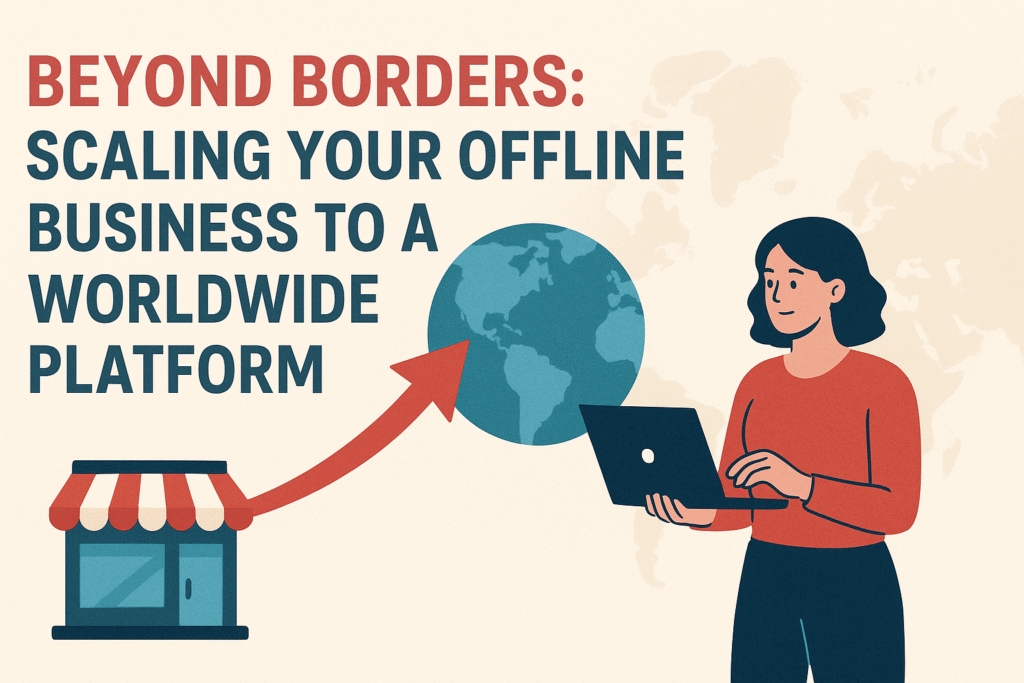
For decades, many businesses thrived by serving their local communities—whether through a brick-and-mortar shop, regional distribution, or face-to-face services. But today, the rules have changed. The digital era has erased geographical boundaries, giving even the smallest businesses the opportunity to operate globally. Expanding beyond borders and scaling your offline business globally is no longer a dream reserved for multinational corporations; it’s a very real possibility for any determined entrepreneur.
If you’ve built a solid offline business and are now considering scaling it to a worldwide platform, the road ahead requires strategy, adaptation, and vision. Here’s how you can take your enterprise from a local stronghold to an international contender.
For expert guidance on scaling your offline business globally, connect with Shri Digital Marketing Solution and take your brand worldwide.
1. Rethinking Your Market: Local Mindset vs. Global Opportunity
When running offline, your customer base is usually limited by geography. You serve the people who can physically visit your store, or who fall within your delivery radius. Transitioning to a global model requires reframing that perspective.
Instead of thinking about your product in terms of “who lives nearby,” ask: Who around the world would benefit from this offering? For example:
A boutique fashion shop in Paris may discover demand in Asia or the U.S. for unique designs.
A small manufacturer in India could find a loyal customer base in Europe looking for sustainable alternatives.
A bakery specializing in gluten-free products may attract niche health-conscious communities globally.
The first step to scaling beyond borders is identifying universal needs your business already addresses and recognizing how those needs manifest across different cultures.
2. Building a Strong Digital Infrastructure
Your offline model thrives on personal presence—storefronts, local advertising, or word of mouth. To scale globally, you need a robust digital backbone that replicates and enhances those functions online.
Key components include:
A professional website or e-commerce store: Think of this as your global storefront. It must be user-friendly, mobile-optimized, and capable of handling international traffic.
Payment solutions: Offer secure and diverse payment options, from credit cards to digital wallets and even local payment systems in key markets.
Logistics integration: Partner with shipping providers that offer reliable cross-border solutions, including customs handling and real-time tracking.
Customer support channels: Email, live chat, or AI-driven bots can replicate the warm in-store service experience for a global audience.
Digital infrastructure is the foundation that allows you to scale without being physically present everywhere.
3. Leveraging Marketplaces and Platforms
Expanding globally doesn’t mean you need to build everything from scratch. Established platforms like Amazon, eBay, Alibaba, or Etsy can serve as springboards for international growth. These marketplaces already have trust, reach, and infrastructure in place, making them powerful allies.
By listing your products on these platforms, you gain instant visibility to millions of international buyers. Over time, as brand recognition grows, you can transition more traffic to your own website, giving you greater control over pricing, branding, and customer relationships.
4. Understanding Cultural Nuances
Scaling globally means entering markets that have different languages, customs, buying habits, and consumer expectations. What works in your home market may not resonate elsewhere.
Consider:
Language localization: Translating your website and marketing materials into key languages improves accessibility and trust.
Cultural preferences: A design, color, or symbol seen positively in one culture might carry negative connotations elsewhere.
Buying behavior: Some regions prioritize discounts and promotions, while others value exclusivity and brand prestige.
Conducting thorough market research or partnering with local experts ensures your messaging and branding remain relevant while respecting cultural differences.
5. Building a Scalable Marketing Strategy
Marketing is the engine that drives your global expansion. Unlike local offline promotions—flyers, billboards, or in-store events—online marketing can reach audiences in every corner of the world.
Effective strategies include:
Search Engine Optimization (SEO): Optimize your content for international search engines to increase visibility.
Social media marketing: Platforms like Instagram, TikTok, and LinkedIn help you connect with audiences across borders.
Influencer partnerships: Collaborating with influencers in your target markets boosts credibility and introduces your brand to new communities.
Content marketing: Blogs, videos, and tutorials establish authority while educating global customers about your products.
The beauty of digital marketing is its ability to scale—your campaigns can be localized and tested in different regions without massive upfront costs.
6. Navigating Legal and Regulatory Challenges
Going global also means dealing with regulations that differ from country to country. These may include:
Import/export rules
Tax obligations (such as VAT in Europe)
Data privacy laws (like GDPR)
Trademark and intellectual property protections
Compliance can feel overwhelming, but it’s essential to avoid legal pitfalls. Consulting international trade experts or hiring legal advisors can save you from costly mistakes.
7. Building Trust Across Borders
Trust is the currency of global commerce. Customers may hesitate to buy from a business they’ve never heard of, located thousands of miles away. To overcome this barrier:
Showcase customer reviews and testimonials prominently.
Offer secure payment gateways and transparent return policies.
Use social proof through media features, certifications, or industry awards.
Maintain clear communication with international customers about shipping times, costs, and policies.
By prioritizing transparency and reliability, you build a global reputation that inspires confidence.
8. The Human Element: Global Teams and Partnerships
Scaling worldwide isn’t just about customers—it’s also about building the right team and partnerships. Hiring remote employees, distributors, or local brand ambassadors helps you establish a presence in key regions.
Technology has made it easy to collaborate across time zones. Tools like Slack, Zoom, and project management platforms allow teams to work seamlessly, no matter where they’re located.
Strategic partnerships—whether with local logistics firms, marketing agencies, or retailers—can accelerate your growth and help you adapt faster to new markets.
Conclusion: Think Global, Act Strategic
Scaling your offline business globally to a worldwide platform is an ambitious journey, but it’s also an exciting one. The key lies in embracing digital transformation, respecting cultural diversity, and building systems that sustain global operations.
Your local business already has a foundation: loyal customers, a tested product, and a proven value proposition. By thoughtfully extending that value to international markets, you can create new revenue streams, diversify risk, and position your brand as a global player.
In today’s interconnected world, the borders that once defined your business are no longer limits—they’re opportunities waiting to be crossed.
